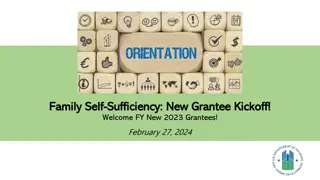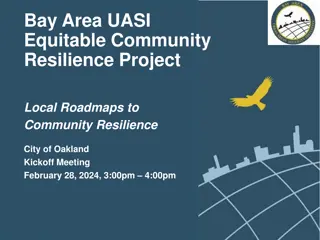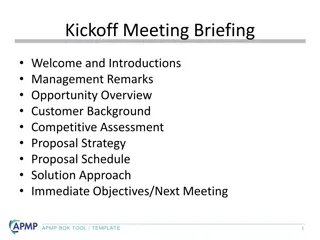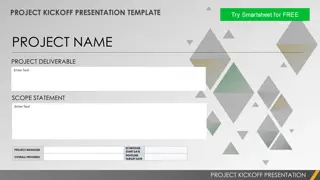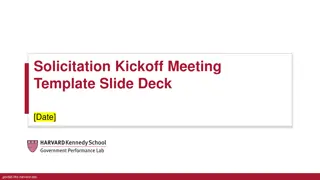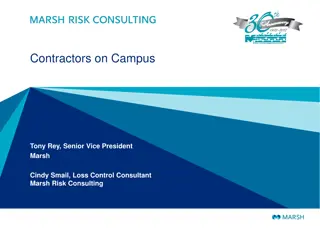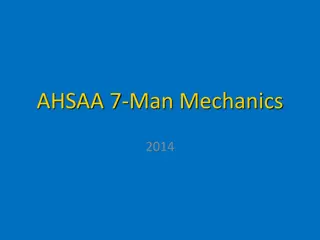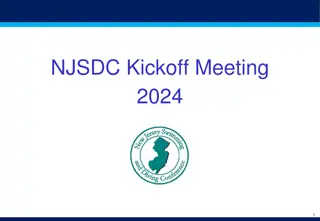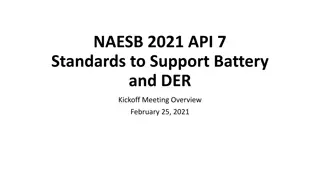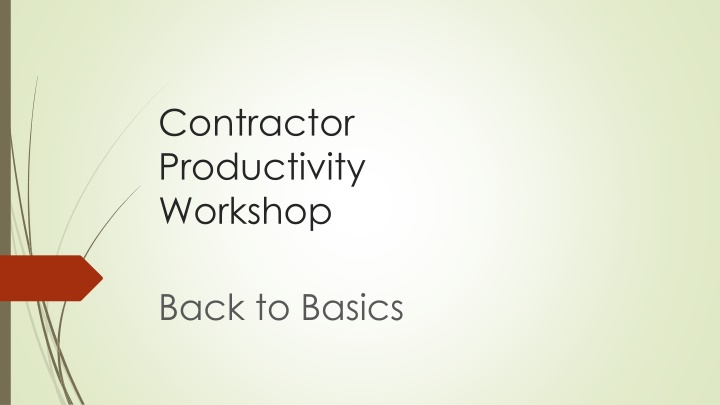
Resistance to Change in a Workshop Environment
Explore a thought-provoking scenario involving monkeys in a cage that illustrates the challenges of change management in a contractor productivity workshop. Discover the importance of communication, training, and trust to overcome resistance and foster a culture of adaptation.
Download Presentation

Please find below an Image/Link to download the presentation.
The content on the website is provided AS IS for your information and personal use only. It may not be sold, licensed, or shared on other websites without obtaining consent from the author. If you encounter any issues during the download, it is possible that the publisher has removed the file from their server.
You are allowed to download the files provided on this website for personal or commercial use, subject to the condition that they are used lawfully. All files are the property of their respective owners.
The content on the website is provided AS IS for your information and personal use only. It may not be sold, licensed, or shared on other websites without obtaining consent from the author.
E N D
Presentation Transcript
Contractor Productivity Workshop Back to Basics
Safety Moment P&S for Safety Proper Planning and Scheduling ensures that you are All in for Safety by preparing the craftsman for the work to be done prior to the start of wrench time
Monkeys in a Cage Start with a cage containing five monkeys. Inside the cage, hang a banana on a string and place a set of stairs under it. Before long, a monkey will go to the stairs and start to climb towards the banana. As soon as he touches the stairs, spray all of the other monkeys with cold water. After a while, another monkey makes an attempt with the same results all the other monkeys are sprayed with cold water. Pretty soon, when another monkey tries to climb the stairs, the other monkeys will try to prevent it. Now, put away the cold water. Remove one monkey from the cage and replace it with a new one.
New Monkeys The new monkey sees the banana and wants to climb the stairs. To his surprise and horror, all of the other monkeys attack him. After another attempt and attack, he knows that if he tries to climb the stairs, he will be assaulted. Next, remove another of the original five monkeys and replace it with a new one. The newcomer goes to the stairs and is attacked. The previous newcomer takes part in the punishment with enthusiasm! Likewise, replace a third original monkey with a new one, then a fourth, and then the fifth. Every time the newest monkey takes to the stairs, he is attacked. Most of the monkeys that are beating him have no idea why they were not permitted to climb the stairs or why they are participating in the beating of the newest monkey.
Monkey Victims After replacing all the original monkeys, none of the remaining monkeys have ever been sprayed with cold water. Nevertheless, no monkey ever again approaches the stairs to try for the banana. Why not? Because as far as they know that is the way it's always been done around here!!!!
Lesson Learned This example shows the need for explaining "Why" for a proposed change and "What's in it for me". Perception that things have always been this way and will not be able to change has to be addresses in terms of "Know how" and "Want to Training, coaching, and showing are needed to address the "Know how" issue "Want to" is more of an attitude and trust issue Learn from this lesson to resolve concerns and to gain understanding and then we will all be willing to "give it a try"
Anatomy of a Breakdown Mean Time To Repair Stoppage Occurs, Breakdown is realized, Mnt is Called Get Mnt Technician on site Diagnose the Fault Get the Spare Part to the job Repair the Fault Test Repair Turnover Setup Startup Repair Time Maint is Called Total Downtime P&S can improve Maint Effectiveness on this Job Repair Time is the Active Maintenance Time Page 7
Wrench Time Performance 100% 8 hr shift Best in Class Performers 75% Craft Wrench Time Typical Results 15 - 35% 50% National Average 25% 0% 8 Actual Craft Wrench Time Hrs Per 8 Hr Shift 4.8 2.16 1.6 Best in Class Performers are at about 60% Page 8
Reasons for Low Wrench Times: Waiting for job assignment/specific instructions Looking for supervisors Checking out the job/Finding out what s happened Finding what s needed to troubleshoot the problem Looking for technical documentation, drawings, manuals Trying to find the right part in the storeroom Multiple trips to the stores for different parts Special tools got to find them or not available Waiting for approval Too many craftsmen per job Poor Planning and Scheduling and Execution practices
NeurologicalTest A Short Neurological Test > 1 - Find the C below.. Please do not use any cursor help. OOOOOOOOOOOOOOOOOOOOOOOOOOOOOOO > OOOOOOOOOOOOOOOOOOOOOOOOOOOOOOO > OOOOOOOOOOOOOOOOOOOOOOOOOOOOOOO > OOOOOOOOOOOOOOOOOOOOOOOOOOOOOOO > OOOOOOOOOOOOOOOOOOOOOOOOOOOOOOO > OOOOOOOOOOOOOOOOOOOOOOOOOOOOOOO > OOOOOOOOOOOOOOOOOOOCOOOOOOOOOOO > OOOOOOOOOOOOOOOOOOOOOOOOOOOOOOO > OOOOOOOOOOOOOOOOOOOOOOOOOOOOOOO > OOOOOOOOOOOOOOOOOOOOOOOOOOOOOOO > OOOOOOOOOOOOOOOOOOOOOOOOOOOOOOO > > 2- If you already found the C, now find the 6 below. > > 99999999999999999999999999999999999999999999999 > 99999999999999999999999999999999999999999999999 > 99999999999999999999999999999999999999999999999 > 69999999999999999999999999999999999999999999999 > 99999999999999999999999999999999999999999999999 > 99999999999999999999999999999999999999999999999 > > 3 - Now find the N below. It's a little more difficult. > > MMMMMMMMMMMMMMMMMMMMMMMMMMMMNMM > MMMMMMMMMMMMMMMMMMMMMMMMMMMMMMM > MMMMMMMMMMMMMMMMMMMMMMMMMMMMMMM > MMMMMMMMMMMMMMMMMMMMMMMMMMMMMMM > MMMMMMMMMMMMMMMMMMMMMMMMMMMMMMM > > This is NOT a joke. If you were able to pass these 3 tests, you can cancel your annual visit to your neurologist. Your brain is great.Congratulations! > 10
Say what you want and Do what you say Stick to It This process is a common sense approach to doing what we all know are the right things to do.
Planning & Scheduling Work Flow Customer Request Scheduling Week - 4 20% Week - 1 Week - 3 Accurate Review 50% Week - 2 Request for work Accurate Tuesday Status & Churn 70% SOFT Accurate 80% Daily Accurate Wednesday Bundling Sequencing S Work Package Task needed PPE Priority Location Size Work Hours Quantity Resources Dependencies Early start Late finish Etc HARD Week - 0 Thursday Scheduling Walk-down Sequence Bundling Etc Planned Unscheduled Unplanned Unscheduled Planned Ready to Scheduled Execution Week Frozen Sequenced Scheduled Complete Job Packages Fill-In Planning Pull-Forward Page 12 Emergency Jobs
Planning & Scheduling Sample Framework Client / Owner provides 4-Week look ahead with Week 1 at least 80% and Week 2 at least 70% accurate by Tuesday for each work type Crafts initiate walk downs to identify bundling opportunities for feedback to scheduler on Wednesday for Week 1 input Wednesday Review sessions must be held with all involved parties (Routine Maintenance, Projects, Major Maintenance and T/A input between Owner and all execution forces) Frozen schedule is set on Thursday for next week execution Break-ins are defined as any jobs performed that were not on Thursday frozen schedule Operations controls work and Maintenance/Contractor Services manages the resources to maximize the workforce with flexibility to complete requested jobs. Crafts finishes work as scheduled to meet agreed upon completion dates
Sample Schedule Template Shows example tracking tool for schedule performance Jobs on Frozen Schedule # HW Sched Jobs Worked >>> TOTAL # Jobs Worked >>> # Jobs on HW Schedule >>> # E-Tickets & Sched Breakers >>> # HW Jobs Worked Out of Sequence >>> 8 24 11 16 6 22 4 20 4 16 3 19 4 3 19 80 23 61 15 76 20 4 16 3 19 16 4 13 3 16 Total Churn >>> Week 1 Hard Week Jobs ONLY All Other Jobs Worked NOT ON HARD WEEK SCHED HW Jobs Worked Out of Sequence Work Center Sched Work Date Actual Work Date Work Center Actual Work Date Work Order & Operation Operations Short Text UNIT Functional Location Work Order & Operation Operations Short Text UNIT Functional Location V-U114 build scaffold for blind DK-S2111 build scaffolds for blinds 91094064-0015 ZGBASB UTIL A005-WT-V-U114 6/25/2012 6/26/2012 1 91107951-0004 ZGBASB AOID A005-AO2-K-S2111 6/25/2012 DK-S2111 build scaffolds for blinds C-OU201 MODIFY SCAFFOLD 91107951-0004 ZGBASB AOID A005-AO2-K-S2111 6/25/2012 6/25/2012 - 91108266-0045 ZGBASB HFE A005-OIU-UNIT_VALVE 6/25/2012 C-OU201 MODIFY SCAFFOLD C-OU201 MODIFY SCAFFOLD 91108266-0045 ZGBASB HFE A005-OIU-UNIT_VALVE 6/25/2012 7/1/2012 1 91108266-0045 ZGBASB HFE A005-OIU-UNIT_VALVE 6/26/2012 B-K2762-2 build scaffold C-OU201 MODIFY SCAFFOLD 91112348-0010 ZGBASB HFE A005-K4-B-K2762-2 6/25/2012 6/26/2012 1 91108266-0045 ZGBASB HFE A005-OIU-UNIT_VALVE 6/26/2012 V-U114 build scaffold for blind C-OU201 MODIFY SCAFFOLD 91094064-0015 ZGBASB UTIL A005-WT-V-U114 6/25/2012 6/26/2012 1 91108266-0045 ZGBASB HFE A005-OIU-UNIT_VALVE 6/26/2012 DK-S2111 build scaffolds for blinds C-OU201 MODIFY SCAFFOLD 91107951-0004 ZGBASB AOID A005-AO2-K-S2111 6/25/2012 6/25/2012 - 91108266-0045 ZGBASB HFE A005-OIU-UNIT_VALVE 6/26/2012 C-OU201 MODIFY SCAFFOLD C-OU201 MODIFY SCAFFOLD 91108266-0045 ZGBASB HFE A005-OIU-UNIT_VALVE 6/25/2012 7/1/2012 1 91108266-0045 ZGBASB HFE A005-OIU-UNIT_VALVE 6/27/2012 Click here to expand B-K2762-2 build scaffold B-K2762-2 build scaffold C-OU201 MODIFY SCAFFOLD 91112348-0010 ZGBASB HFE A005-K4-B-K2762-2 6/25/2012 6/26/2012 1 91108266-0045 ZGBASB HFE A005-OIU-UNIT_VALVE 6/27/2012 C-OU201 MODIFY SCAFFOLD - 91108266-0045 ZGBASB HFE A005-OIU-UNIT_VALVE 6/27/2012 C-OU201 MODIFY SCAFFOLD C-OU201 MODIFY SCAFFOLD 91108266-0045 ZGBASB HFE A005-OIU-UNIT_VALVE Fill-In - 91108266-0045 ZGBASB HFE A005-OIU-UNIT_VALVE 6/27/2012 C-OU201 MODIFY SCAFFOLD 91112348-0010 ZGBASB HFE A005-K4-B-K2762-2 Fill-In - 91108266-0045 ZGBASB HFE A005-OIU-UNIT_VALVE 6/27/2012 V-U114 build scaffold for blind C-OU201 MODIFY SCAFFOLD 91094064-0015 ZGBASB UTIL A005-WT-V-U114 Fill-In - 91108266-0045 ZGBASB HFE A005-OIU-UNIT_VALVE 6/27/2012 C-OU201 MODIFY SCAFFOLD - 91108266-0045 ZGBASB HFE A005-OIU-UNIT_VALVE 6/27/2012 C-OU201 MODIFY SCAFFOLD - 91108266-0045 ZGBASB HFE A005-OIU-UNIT_VALVE 6/28/2012 C-OU201 MODIFY SCAFFOLD - 91108266-0045 ZGBASB HFE A005-OIU-UNIT_VALVE 6/28/2012 C-OU201 MODIFY SCAFFOLD - 91108266-0045 ZGBASB HFE A005-OIU-UNIT_VALVE 6/28/2012 - Fill-In Jobs on Frozen Schedule All Jobs completed not on Frozen Schedule Page 15
How can our Pilot create Value? There are two basic ways to create value by impacting contractor services: 1.Taking reactionary work out of the system (limit to true emergency jobs) 2.Improve workforce productivity
Taking Work Out of the System Take work out of the system through root cause elimination of the defect (solve vs. patch the problem) or eliminating inefficiencies Properly P&S so each job can be done as efficiently as possible and therefore: There can be a reduction in the time to do (man hours) Reduce material usage and wasted movements
Craft Productivity Improvement Improving the productivity of the contractor workforce Get more work done with the same amount of working hours (Improved Wrench Time) Get the same amount of work done with less resources (reduce OT) Improved productivity will also result in: Shorter time for repairs Lower material cost and use This is a powerful but often ignored potential to create value
Definition of Wrench Time Wrench time is defined as the percentage of time a Craftsperson has A Wrench in His / Her Hands Fixing the Equipment (doing the Work Order). This definition eliminates all time spent traveling to / from jobs, time spent looking for parts, searching for instructions or documentation, time spent identifying parts or material to be ordered, Lock out/Tag out, permits, etc. Wrench time is a general reflection of the effectiveness of the work planning, resource scheduling, work management, plant coordination, plant programs, and other supporting work processes. It is a measure of all those activities that prevent the Craftsperson from focusing on their primary responsibility of working on the equipment
Continual Improvement Change occurs one step at a time and we each can make a difference Team members support each other Working together, we can change our culture to enhance our partnership Build pride off of success
P&S Roles & Responsibilities for Key Players in the Pilot: Planners Adds value for craftsman through understanding and preparation of job request prior to start of tool time (provides answers to crew questions) Schedulers Assigns resources at optimum time to allow most efficient execution of each job request (resource coordination) Productivity Coordinator Mentors crews by field explanations for efficiency and productivity gains. Contractor Services Collects and analyzes data to drive work process improvements. Maintenance Coordinator Provides single voice for Operations input and setting overall priority.
Partnership Expectations Safety Continue to meet or exceed Safety Performance Quality Take Pride in the Finished product, Do it right the first time. Production Meet or exceed job performance expectations This is done through Participation in the planning and scheduling process Accurately quantify and scope all job packages by participating in field job walk-downs Look for efficiencies in execution when walking down packages: Order of Execution Pairing of Builds and Demo s/Bundling work Geography / Zones Timing Provide Feedback to Planners and Management Pre .Execution .Post
Planning Proper Scope Definition Document requirements for all work requests excluding Break-ins Scope sheets to include adequate information to allow execution forces to plan work 1. Description of work needed (i.e. pull valve #, tighten bolts on exchanger #, etc.). 2. Location of work (include base elevation if different than ground) Provide pictures when possible 3. Provide early start and late finish dates/times 4. Ensure consistent information in source computer system (all required fields populated, PO/WO numbers, etc.) 5. Any known special PPE or needed hazard mitigation 6. Owner contact information (answer question and support walk down of work area)
Planning Job Packages Job Package content required: (determine the appropriate level of information for each job) 1. Feedback from field walk down by Maintenance or contractor planner is documented to answer crew questions 2. Job cost and man hour estimates provided as productivity targets for the crew. Resources loaded based these estimates. 3. Digital pictures provided for location and scaffold orientation 4. Any needed drawings and instructions provided (work method and specifications) 5. Materials identified and parts staged in area or delivered by Material Coordinator 6. Potential work bundling opportunities identified for other jobs in the same area 7. Support equipment and tools identified and available 8. Define permit needs for Operations to perform prep work
Productivity Coordinators Expectations for Managing & Executing Work Schedule Compliance Working the Plan with the Crews Know your work plan o For the Week, for the Day, by the hour .. Look for efficiency gains Anticipate hurdles and roadblocks Elevate concerns promptly Communicate your needs Start on time or early Work till end of shift Use Common Sense for Breaks Document Delays, Break-ins and Churn Document Hours Spent for day by work order number
Executing Work with Operations Operations Interaction Share your work plan with Operations including Order of Execution Obtain Approval of Delays as they Occur Obtain Approvals of Breakers as they Occur Document Contact Name and Instructions when asked to deviate from plan and communicate immediately Specific jobs jointly agreed by Operations and Maintenance that are true emergencies due to extenuating circumstances of work environment or scope will be addressed immediately Elevate Concerns for resolution
Capture all Delays Document o Date and Time Stop and Restart o Cause of delay o Employees affected by the delay, by name o Location and tag number o Obtain Requestor s Signature/Approval (verbal is not good enough) Communicate delay in work plan to Contractor Services Lead Planning/Management will authorize execution of Breakers Examples of Delays: o Permitting time (Starts when entering control room) o Standby should be documented and signed for o Traffic Train, Crane, Auto o Audit Teams (Other than Brock Jacobs) o Process Upset o Lifts, Testing, audits,. .etc.
Expected Outcomes Gain Operations, Maintenance, Contractors and Contractor Services support Get the basics in place first: The key is Planning, Scheduling and Execution. We all play a part. Work together to resolve identified barriers. Success is a Team effort: Celebrate each improvement What gets rewarded, gets done Recognize and reward those meeting Safety, Quality and Performance expectations. A sincere Thank You goes a long way.
Tools for use with Crews: Problem Solving Process The following 4-Step Problem Solving Process can be used to address Site and Regional problems: When addressing a cultural change, the following questions will lead you through a logical sequence to identify causes/roadblocks and solutions to drive implementation. What is happening now? This defines the current state What should be happening? This defines the ideal state we want to achieve Vision Why is it the way it is now? This defines a list of causes or rationalizations for the way it is now (we have always done it this way, etc.) gaps to resolve Note: There is a tendency, often times to jump to solutions, at this point. Keep the group focused on possible causes . What do we need to do to make it be the way we want it to be? We will need to prioritize the causes and our actions.
Work Flow Development Process Do a Post It session with input collected for the following focus areas: safety, request work, plan work, field input, schedule work, permit process, execute work and invoice process for What is happening now The As Is State Capture Best Practices (things we are doing good) and Quick Fixes to be addressed through projects Develop the desired To Be work flow process based on gaps from what you learned
Value of action items or improvements What is each action worth? We need to assign a value to each action item to know the value being gained by performing the action. Be conservative, consistent and have a basis when determining the value. Use its worth to prioritize which items will provide the biggest gains. Use worth to quantify savings (time and money) for each action taken. Document projected savings to show potential impact on site costs. Track actual savings achieved.
Basis for Savings Basis for savings Time on tool as is before change is made Time on tool after implementation of improvement Minutes per day. # Days per week that it applies. Minutes saved out of total available minutes. Number of jobs per day that apply. Number of crew members where it applies.
Contractor Crew Improvement Projects Date completed: Team members (List the names of contributors): Project description: Key initiative area addressed: Customer Satisfaction, Safety / Environmental, Equipment reliability Cost Savings, Quality, Personnel Development What measure and work process does this affect? Status and results achieved: Basis and calculation of savings: Supervisor: _______________________ Send completed form to Productivity Coordinator for feedback and recognition
With full Management support, Team unstoppable Anything is possible



